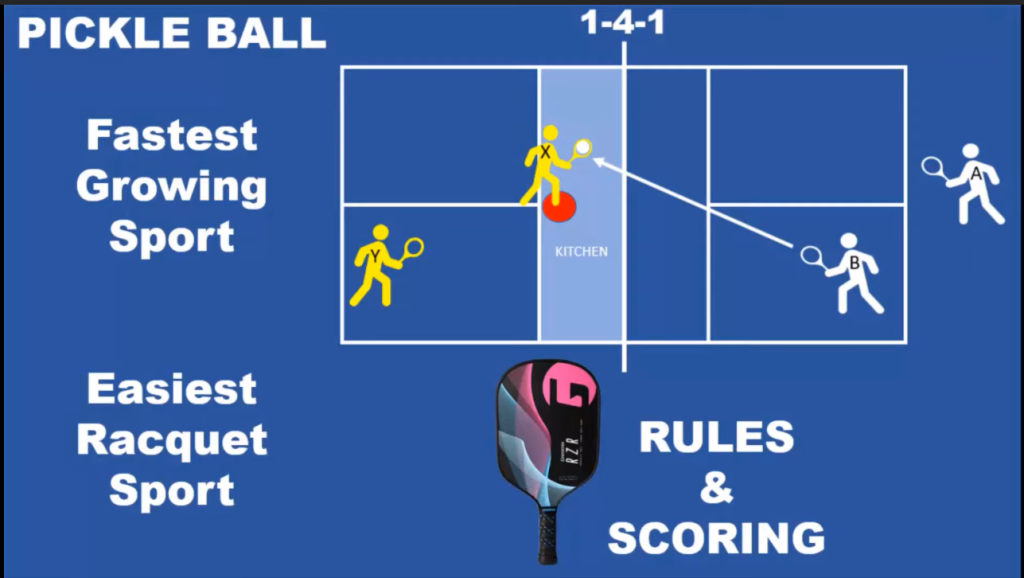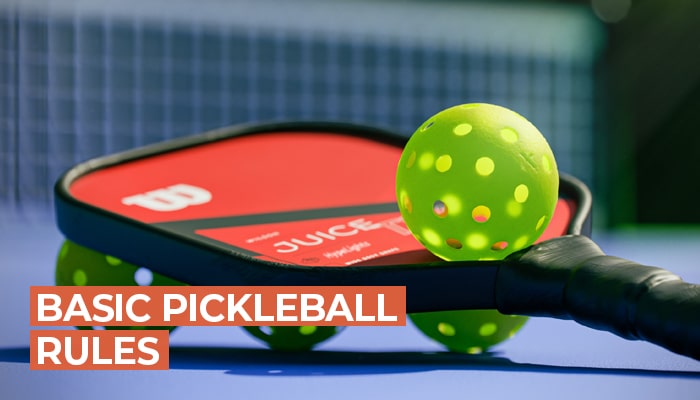The essential principles of the game are straightforward and simple, making Pickleball amusing to play. Here I am presenting some important rules you should be aware of before starting a game. However, more advanced pickleball instructions will be provided as players progress.
Foundation:
The aim of Pickleball took place with the goal that all individuals from a family could participate so the standards were kept simple. In order to play this game, numerous rules have been established from other games like badminton, tennis, and ping pong.
The International Federation of Pickleball has introduced the basic rules of Pickleball. The Federation refers to its standards as, IFP Official Tournament Rulebook. These basic standards should be followed for an authorized competition yet variations of the principles can be used for non-endorsed and sporting play. Here are the key guidelines that starting players need to know.
The Principle of Two Bounce Rule:
It is a must for the ball to bounce two times around the court prior to the players hitting the ball on the volley’ or in the air. So when the player serves the ball it must bounce in the opponent’s court. The opponent has to wait for the serve to bounce before they hit it back. Now the first player has to wait for the ball to bounce before he can hit the ball. This is called the double bounce rule where both sides had to wait for the ball to bounce before hitting it. This way both players have allowed the ball to bounce before they hit it back. This is done only the first time they receive the ball. Once this is done any player can hit the ball before it bounces. Implying the players can now hit the ball in the air (before it bounces)
Mentors/teachers should remind the two players in the serving group to remain back at the helpline until the ball has bobbed on their side.
The Rule of Non-Volley Zone Faults/ Kitchen rules:
The area of the Non-Volley Zone is 7 X 20 feet. This is a rectangular shape on either side of the net. The area of this game is so wide that it is easier for the player to stay back from the net when hitting the ball in the air. Hence, it eliminates the risk of injury to a rival player.
Here are some rules you need to keep in mind with respect to the non-volley zone.
- You can not volley the ball in the air while standing in the non-volley zone.
- You can not volley the ball in the air and then step in the non-volley zone while steadying yourself from that particular shot.
- If you are volleying the ball in the air, your feet should be behind the line of the non-volley zone during the shot and afterward while you steady yourself. Once you are steady (it only takes a moment to steady yourself), you may step into the non-volley zone.
- You can however volley the ball inside the non-volley zone if the ball has already bounced.
This is perhaps the most troublesome principle for players to adjust to, especially those playing tennis or watching it. You are also not allowed to drop your accessories in the kitchen zone. Your cap or oar falling in is viewed as an issue.
Central issues. You are just allowed to step in the non-volley zone to pick the already bounced ball but serving a ball from the non-volley zone is considered to be a fault.
As mentioned earlier this rule was adopted for player safety concerns so that players do not get to the net and smash volleys in the air directly at their opponents. This would be a high-risk shot and may result in serious injury to players.
Points:
Now the question arises: how many points are needed to win pickleball? So the answer is: There are eleven points for one round of the game. The winning group should win by two or the play keeps on going until one group wins by 2. The points can be extended to fifteen to twenty in case of a high-level game. The receiving group should get the “side down” and get the serve back prior to procuring points.
Pickleball Rules and Scoring/Scoring Rules:
Scoring in pickleball can be difficult to understand for amateurs. The principal rule of behavior in pickleball is that the server and just the server ought to report the score. The player that is standing on the right hand of the court of the serving side consistently begins. The scoring points are different on different occasions if the scoring point is in an odd number i.e 1,3,5,7 then it is a must for the serving player to be on the left side of the court and if the scoring point is in an even number i.e 2,4,6,8 then it is must for the serving player to be at the right side of the court. This is called pickleball serving rules for doubles.
Serving Rules/Official Pickleball Rules:
The decision of who will serve first will depend upon three times serving between both groups. In those three serves, the team who wins the most will serve first. The group serving initially gets just one serve their first time. This standard helps in preventing “blow” out games with one group getting an enormous number of points to begin. The server making the primary serve ought to declare 0, 0, 2.
The score is 0, 0, and on the grounds that the group gets just one server, the server is number 2. When the serve changes to the opposite side, they get two serves, and then the play proceeds that way until a score of 11 is reached. The same rule will be used for playing singles in pickleball.
The rule of serving is that the server should serve underhand connecting with the ball below the wrist level. This means that the oar’s face should be below his wrist and not any part of the oar can be above the wrist. The server should also be outside the court line at the time of the serve. The ball which is served should land in the opponent’s court diagonally.

This means if the server is standing on the right side of his court, then his serve should land on the left side of the opponent’s court. A serve that hits the net yet crosses over to the opponent’s area, is lawful and play should proceed. Prior to serving the ball, the server should ensure the opponents are prepared. Players should also take a moment to check if their own team is prepared.
Assuming a player is at the receiving end of the serve and is not ready, he should hold up his hand or oar. In the event that the server serves him, at any rate, he should not swing at the ball since he was not prepared.
Pickleball Rules Singles:
The serve should be underhand serve wherein the ball is hit below the server’s naval. The serve should be done behind the court lines. Neither one of the feet may contact the baseline or the court until after the serve is struck. The serve should hit the opponent’s serve region which is diagonal across the server.
Calling Lines/ Pickleball Line Rules:
The honesty of the players matters a lot in this game of pickleball. Both parties are required to call the lines. First things first, you need to understand that if any part of the ball hits the court borderline, the ball is considered to have bounced inside the court.
If the player receiving the ball is uncertain whether the ball was in or out, the benefit of the doubt goes to the opponents. If the player is certain the ball bounced outside, the line call has to be made immediately and not after some time. In case both players are unable to settle a line call, the benefit of the doubt once again goes to the opponents. Once more, decency is the standard of the day.
Faults:
- All faults, including foot errors; contacting the net or post; bouncing ball; ball contacting player or apparel in the air; breach of any standard; can be called a fault by a group.
- The point when a server’s foot breaches the court region or is outside the designated region of the sideline and centerline at the time of serve can be called a fault.
- Net help post: Any ball hitting the side posts is a dead ball.
- If the ball goes outside of the court without bouncing inside the court, it is considered a fault
- The ball hits a player: If the ball contacts a player prior to bobbing, regardless of whether you are inside or outside the court limits, it is a fault.
- All Non-Volley Zone breaches are faults.
What are the 5 rules of pickleball?
The five principles of pickleball are that the ball should remain inside the playing court, there ought to be one skip for each side, serving should be done outside the guideline, the serve can’t land in the no-volley zone, and the game finishes at 11, 15, or 21 points. These rules are also called pickleball court rules.
Pickleball Skinny singles rules:
In skinny singles, players play in only half the part of the court. If both players are using the same half of their court (which could be either left or right) it is called playing down the line. If one is using the left half and the other is using the right half of his court then this is called playing across the line.
